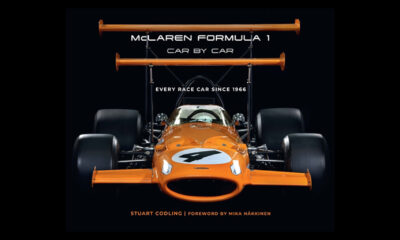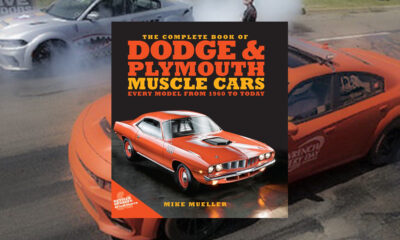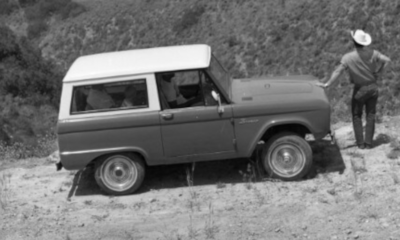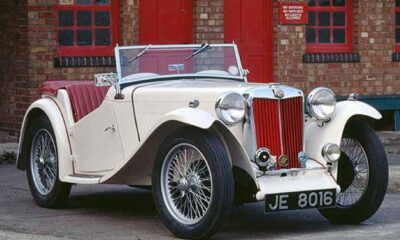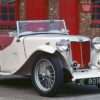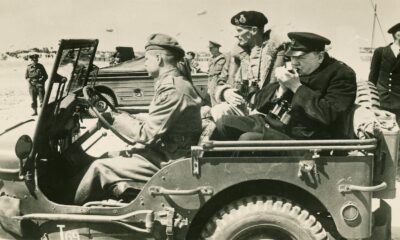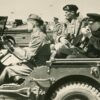Book Review
PONTIAC FIREBIRD: THE AUTOBIOGRAPHY – CHICKEN SOUPED
PONTIAC FIREBIRD: THE AUTOBIOGRAPHY
CHICKEN SOUPED
I was seventeen and a junior in high school when I bought my first new car, a 1967 Pontiac Firebird hardtop, in medium blue with a V-8 and 4-speed. So why was I a Pontiac man when I could have bought a Camaro or Mustang, or one of the other ponycars? Two reasons: I loved the front end of the 1st-generation Firebird. And while I really wanted the GTO my parents wouldn’t let me buy, a Firebird was a close second. The Firebird’s two-barrel V-8 probably served me well while my unbridled enthusiasm of youth ran its course in high school. And two years later I got that GTO!
Ron Hector, Dallas
As a kid, I took piano lessons in downtown Lincoln, Nebraska, right around the corner from Lincoln’s Pontiac dealer. At that point – I’m thinking ’64 and ’65, as we moved to Omaha in the summer of ’65 – a Pontiac showroom was chock full of wide-tracking Pontiacs, but its centerpiece was the recently introduced GTO. The GTO, which was essentially Pontiac’s pedestrian Tempest stuffed with 389 cubic inches of big block V8, served as the opening act for the GM division’s lineup of performance art. And while the Firebird, introduced as a midseason model in 1967, was but one piece of the performance pie, it was an aspirational piece, especially for a kid growing real tired of piano lessons.
If your memory of the ‘60s and ‘70s is fading almost as fast as mine, there are few better ways of recalling your automotive youth than a title devoted to one of the decade’s most pivotal intros, the Pontiac Firebird. And in the niche category of automotive journalism, few titles will better prepare you for the always-fab Firebird than Marc Cranswick’s PONTIAC FIREBIRD: The AutoBiography, now in its 4th edition. First published in 2003, and with this most recent revision now landing in bookstores, Mr. Cranswick provides a granular look at GM’s ‘sporty’ coupe in all its iterations, and not incidentally, the car’s pervasive presence in the Smokey and the Bandit franchise.
The story begins simply enough. Given Ford’s success with the Mustang in the spring of ’64, it was incumbent on GM to counter with something appealing to the growing Boomer audience (the oldest of which was about to turn 20); the General quickly recognized that a performance-oriented Corvair wouldn’t do the sales volume Ford had acquired – and GM wanted. GM’s initiative resulted in Chevy’s Camaro, and with FoMoCo developing Lincoln-Mercury’s upscale Cougar, it was decided Pontiac would counter with a sporty compact of its own.
Taking its name from Motorama concepts of the ‘50s, Pontiac’s take on the Camaro was expedient, but in their modest attempt at differentiation the Pontiac team was generally successful. The face of the Firebird became a slightly extended, chrome-covered fascia, while its taillight treatment was borrowed from another GM concept, the Banshee. And under the Firebird’s hood was not only a honking 400 cubic inch V8, but also a Euro-inspired SOHC inline six crafted from Chevy’s pushrod 250-cubic inch lump. The result was a Euro-inspired counterpoint to Chevy’s Made-in-America Camaro; a cravat, if you will, rather than the Camaro’s bow tie. And in the Firebird’s first year it was, in sales speak, a firecracker.
Of course, in the spirit of GM chairman Alfred P. Sloan (1875-1966), design and platform changes were right around the corner. Once again sharing a platform with the Camaro, in 1970 an all-new Firebird was launched, with an even more GT-specific design and a 1970½ designation. And it was – in a word – drop-dead gorgeous. Author Cranswick’s granular research is rich in detail; obviously, Cranswick covers the powertrain offerings, but he also details changes made to heating and ventilation, available steering systems and what GM’s engineering team wanted in the way of braking; or, in the case of early drum brakes, no braking. In support of this detail is a splendid array of Firebird photography, illustrating both street and racing – think Trans-Am – variants.
In its four generations and 35 years of production, the Firebird enjoyed most of the highs – and all of the lows – associated with GM and the domestic auto industry. Safety and emission regulations hit the Camaro/Firebird platforms hard in the ‘80s, while public indifference to sporty coupes took its toll in the ‘90s. Of course, a platform running for some ten years while receiving only the occasional refresh also has a corrosive effect on sales; sporty coupe sales get a bounce from their ‘flavor of the month’ appeal, and once a given number of consumers have sampled the flavor, business tends to taper off. And so did the Firebird, ending its run at the end of the 2002 model year.
Marc Cransick provides a credible, substantive overview of all that is the Firebird. If only my autobiography was as interesting as Mr. Cranswick’s…
The book, PONTIAC FIREBIRD: The AutoBiography, is published by Veloce Publishing. It is available in the U.S. – for $50 – via your local bookseller. My thanks to the Veloce Publishing team for providing a review copy.






